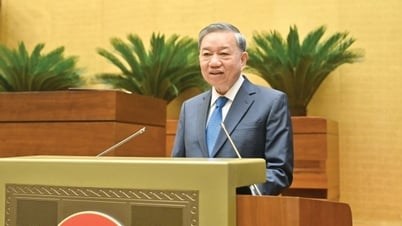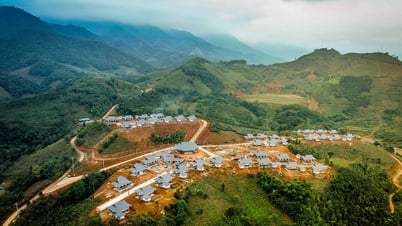Saudi Arabia's Energy Ministry said on June 4 that the country's oil production will fall from about 10 million barrels per day in May to 9 million barrels per day in July.
Earlier the same day, after 7 hours of negotiations in Vienna, Austria, the alliance between the Organization of the Petroleum Exporting Countries (OPEC) and non-OPEC producers including Russia (referred to as OPEC+) decided to extend the production cut by 1.4 million barrels per day until the end of 2024.
Oil prices rose in trading on June 5 following Saudi Arabia's decision.
Saudi Arabia's reduction in oil supply is seen as a unilateral move to support falling crude oil prices, after two previous cuts by major producers in OPEC+ failed to push oil prices up.
The bold move by the OPEC leader comes at the cost of concessions to two other key members, Russia and the United Arab Emirates (UAE). Russia has not committed to cutting production in the near future, while the UAE has secured a larger oil production quota for 2024.

An employee works at an oil pumping station on the outskirts of Almetyevsk, Russia, on June 4. Photo: REUTERS
Saudi Arabia's Energy Minister Abdulaziz bin Salman Al-Saud affirmed that he will do everything necessary to stabilize the energy market in the context of oil prices being under great pressure from economic downturn forecasts in many countries, especially China.
According to Bloomberg , the remaining members of OPEC+ have not taken any action to boost oil prices despite pledging to maintain current production until the end of 2024. Previously, in October 2022, OPEC+ announced a cut of 2 million barrels/day, causing the US to react. Thus, OPEC+ has committed to reducing 4.6 million barrels/day, equivalent to 4.5% of global demand.
Mr. Bob McNally, President of Rapidan Energy Analysis Company (USA), commented to CNBC: "We see a large global deficit occurring in the second half of 2023 and crude oil prices will exceed $ 100 / barrel next year."
Commonwealth Bank of Australia also said Saudi Arabia would increase production cuts in July if Brent crude oil prices remained at or below $70-75 a barrel.
Jorge Leon, senior vice president of oil market research at Norwegian energy research firm Rystad Energy, said the new cuts could push oil prices higher in the short term, but the impact would depend on whether Saudi Arabia would extend the cuts.
Saudi Arabia needs sustained high oil revenues to fund ambitious projects aimed at diversifying its economy. The International Monetary Fund estimates that the country wants oil prices to reach $80.90 a barrel to meet its spending plans, including the $500 billion “Neom” desert city project.
However, too high oil prices can fuel inflation, reduce purchasing power and force central banks such as the US Federal Reserve (FED) to continue raising interest rates, thereby slowing economic growth.
The U.S. recently added to its Strategic Petroleum Reserve after President Joe Biden announced a record-breaking release last year to support oil prices, a sign that U.S. officials may be less worried about OPEC's latest production cuts.
Meanwhile, Saudi Arabia’s production cuts and any rise in oil prices could boost Russia’s revenues. Russian Deputy Prime Minister Alexander Novak told Rossiya-24 TV channel that Russia would adjust its crude oil production level to 9.8 million barrels per day from January 1, 2024, and taking into account the previously announced additional voluntary reduction of 500,000 barrels per day, the final target would be 9.3 million barrels per day.
Source


![[Photo] President Luong Cuong presents the 40-year Party membership badge to Chief of the Office of the President Le Khanh Hai](https://vphoto.vietnam.vn/thumb/1200x675/vietnam/resource/IMAGE/2025/5/19/a22bc55dd7bf4a2ab7e3958d32282c15)


![[Photo] General Secretary To Lam attends the conference to review 10 years of implementing Directive No. 05 of the Politburo and evaluate the results of implementing Regulation No. 09 of the Central Public Security Party Committee.](https://vphoto.vietnam.vn/thumb/1200x675/vietnam/resource/IMAGE/2025/5/19/2f44458c655a4403acd7929dbbfa5039)
![[Photo] Panorama of the Opening Ceremony of the 43rd Nhan Dan Newspaper National Table Tennis Championship](https://vphoto.vietnam.vn/thumb/1200x675/vietnam/resource/IMAGE/2025/5/19/5e22950340b941309280448198bcf1d9)
![[Photo] Close-up of Tang Long Bridge, Thu Duc City after repairing rutting](https://vphoto.vietnam.vn/thumb/1200x675/vietnam/resource/IMAGE/2025/5/19/086736d9d11f43198f5bd8d78df9bd41)
















































































![[VIDEO] - Enhancing the value of Quang Nam OCOP products through trade connections](https://vphoto.vietnam.vn/thumb/402x226/vietnam/resource/IMAGE/2025/5/17/5be5b5fff1f14914986fad159097a677)



Comment (0)